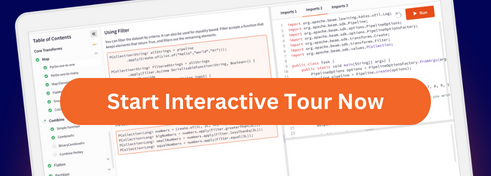blog
2021/06/08
How to validate a Beam ReleasePablo Estrada [@polecitoem]
Performing new releases is a core responsibility of any software project. It is even more important in the culture of Apache projects. Releases are the main flow of new code / features among the community of a project.
Beam is no exception: We aspire to keep a release cadence of about 6 weeks, and try to work with the community to release useful new features, and to keep Beam useful.
Configure a Java build to validate a Beam release candidate
First of all, it would be useful to have a single property in your pom.xml
where you keep the global Beam version that you’re using. Something like this
in your pom.xml:
Second, you can add a new profile to your pom.xml file. In this new profile,
add a new repository with the staging repository for the new Beam release. For
Beam 2.27.0, this was https://repository.apache.org/content/repositories/orgapachebeam-1149/.
Once you have a beam.version property in your pom.xml, and a new profile
with the new release, you can run your mvn command activating the new profile,
and the new Beam version:
mvn test -Pvalidaterelease \
-Dbeam.version=2.27.0 \
-Dbeam.release.repo=https://repository.apache.org/content/repositories/orgapachebeam-XXXX/
This should build your project against the new release, and run basic tests. It will allow you to run basic validations against the new Beam release. If you find any issues, then you can share them before the release is finalized, so your concerns can be addressed by the community.
Configuring a Python build to validate a Beam release candidate
For Python SDK releases, you can install SDK from Pypi, by enabling the installation of pre-release artifacts.
First, make sure that your requirements.txt or setup.py files allow
for Beam versions above the current one. Something like this should install
the latest available version:
apache-beam<=3.0.0
With that, you can ask pip to install pre-release versions of Beam in your
environment:
pip install --pre apache-beam
With that, the Beam version in your environment will be the latest release candidate, and you can go ahead and run your tests to verify that everything works well.
Validating Prism Runner RC against RC SDKs
Replace v2.59.0-RC1 with the tag of the RC version being validated.
Python
To validate the prism runner with Python,
--runner=PrismRunner --prism_location=https://github.com/apache/beam/releases/tag/v2.59.0-RC1 --prism_beam_version_override=v2.59.0
- The
runnerflag sets Beam to use Prism. - The
prism_locationsets the source of Prism assets. - The
prism_beam_version_overrideflag sets what those artifacts are labeled as. - The assets are packaged as the final release version, so the override is required.
Java
For Gradle, add the Prism, and the JAMM depdendencies to your build.gradle.
implementation "org.apache.beam:beam-runners-prism-java:2.59.0"
implementation "com.github.jbellis:jamm:0.4.0"
Then add the following flags, substituting the version accordingly.
`–runner=PrismRunner –prismLocation=“https://github.com/apache/beam/releases/tag/v2.59.0-RC1/" –prismVersionOverride=v2.59.0
- The
runnerflag sets Beam to use Prism. - The
prismLocationsets the source of Prism assets, specifically the zip file of the version in question.
Configuring a Go build to validate a Beam release candidate
For Go SDK releases, you can fetch the Go SDK RC using go get,
by requesting the specific pre-release version.
For example, to request the first release candidate for 2.44.0:
go get -d github.com/apache/beam/sdks/v2@v2.44.0-RC1
With that, the Beam version in your go.mod will be the specified release candidate.
You can go ahead and run your tests to verify that everything works well.
You may need to also specify the RC’s matching container when running a job.
Use the --environment_config flag to specify the release candidate container:
eg. --environment_config=apache/beam_go_sdk:2.44.0rc1
Latest from the blog
blog & gsoc
2025/10/14
Google Summer of Code 2025 - Enhanced Interactive Pipeline Development Environment for JupyterLab
Canyu Chen
blog & gsoc
2025/09/26
Google Summer of Code 2025 - Beam ML Vector DB/Feature Store integrations
Mohamed Awnallah
blog & gsoc
2025/09/23
Google Summer of Code 2025 - Beam YAML, Kafka and Iceberg User Accessibility
Charles Nguyen



